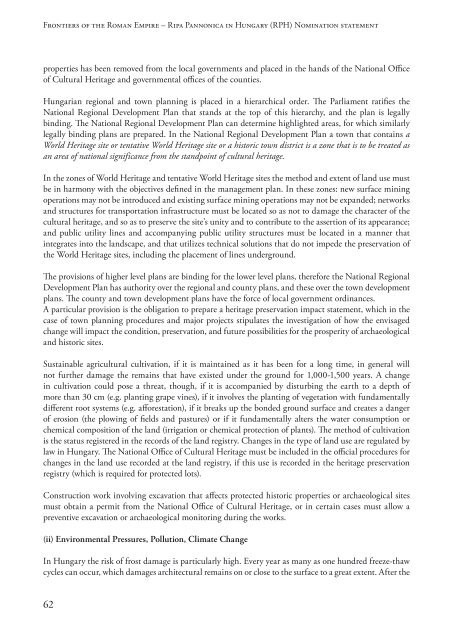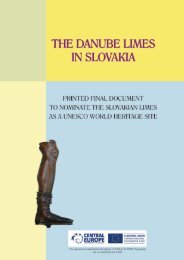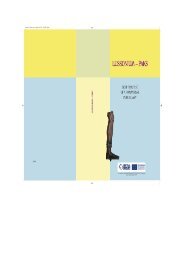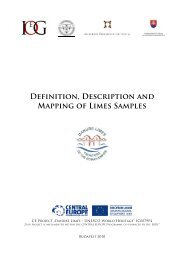the PDF version! - Danube Limes
the PDF version! - Danube Limes
the PDF version! - Danube Limes
You also want an ePaper? Increase the reach of your titles
YUMPU automatically turns print PDFs into web optimized ePapers that Google loves.
Frontiers of <strong>the</strong> Roman Empire – Ripa Pannonica in Hungary (RPH) Nomination statement<br />
properties has been removed from <strong>the</strong> local governments and placed in <strong>the</strong> hands of <strong>the</strong> National Office<br />
of Cultural Heritage and governmental offices of <strong>the</strong> counties.<br />
Hungarian regional and town planning is placed in a hierarchical order. The Parliament ratifies <strong>the</strong><br />
National Regional Development Plan that stands at <strong>the</strong> top of this hierarchy, and <strong>the</strong> plan is legally<br />
binding. The National Regional Development Plan can determine highlighted areas, for which similarly<br />
legally binding plans are prepared. In <strong>the</strong> National Regional Development Plan a town that contains a<br />
World Heritage site or tentative World Heritage site or a historic town district is a zone that is to be treated as<br />
an area of national significance from <strong>the</strong> standpoint of cultural heritage.<br />
In <strong>the</strong> zones of World Heritage and tentative World Heritage sites <strong>the</strong> method and extent of land use must<br />
be in harmony with <strong>the</strong> objectives defined in <strong>the</strong> management plan. In <strong>the</strong>se zones: new surface mining<br />
operations may not be introduced and existing surface mining operations may not be expanded; networks<br />
and structures for transportation infrastructure must be located so as not to damage <strong>the</strong> character of <strong>the</strong><br />
cultural heritage, and so as to preserve <strong>the</strong> site’s unity and to contribute to <strong>the</strong> assertion of its appearance;<br />
and public utility lines and accompanying public utility structures must be located in a manner that<br />
integrates into <strong>the</strong> landscape, and that utilizes technical solutions that do not impede <strong>the</strong> preservation of<br />
<strong>the</strong> World Heritage sites, including <strong>the</strong> placement of lines underground.<br />
The provisions of higher level plans are binding for <strong>the</strong> lower level plans, <strong>the</strong>refore <strong>the</strong> National Regional<br />
Development Plan has authority over <strong>the</strong> regional and county plans, and <strong>the</strong>se over <strong>the</strong> town development<br />
plans. The county and town development plans have <strong>the</strong> force of local government ordinances.<br />
A particular provision is <strong>the</strong> obligation to prepare a heritage preservation impact statement, which in <strong>the</strong><br />
case of town planning procedures and major projects stipulates <strong>the</strong> investigation of how <strong>the</strong> envisaged<br />
change will impact <strong>the</strong> condition, preservation, and future possibilities for <strong>the</strong> prosperity of archaeological<br />
and historic sites.<br />
Sustainable agricultural cultivation, if it is maintained as it has been for a long time, in general will<br />
not fur<strong>the</strong>r damage <strong>the</strong> remains that have existed under <strong>the</strong> ground for 1,000-1,500 years. A change<br />
in cultivation could pose a threat, though, if it is accompanied by disturbing <strong>the</strong> earth to a depth of<br />
more than 30 cm (e.g. planting grape vines), if it involves <strong>the</strong> planting of vegetation with fundamentally<br />
different root systems (e.g. afforestation), if it breaks up <strong>the</strong> bonded ground surface and creates a danger<br />
of erosion (<strong>the</strong> plowing of fields and pastures) or if it fundamentally alters <strong>the</strong> water consumption or<br />
chemical composition of <strong>the</strong> land (irrigation or chemical protection of plants). The method of cultivation<br />
is <strong>the</strong> status registered in <strong>the</strong> records of <strong>the</strong> land registry. Changes in <strong>the</strong> type of land use are regulated by<br />
law in Hungary. The National Office of Cultural Heritage must be included in <strong>the</strong> official procedures for<br />
changes in <strong>the</strong> land use recorded at <strong>the</strong> land registry, if this use is recorded in <strong>the</strong> heritage preservation<br />
registry (which is required for protected lots).<br />
Construction work involving excavation that affects protected historic properties or archaeological sites<br />
must obtain a permit from <strong>the</strong> National Office of Cultural Heritage, or in certain cases must allow a<br />
preventive excavation or archaeological monitoring during <strong>the</strong> works.<br />
(ii) Environmental Pressures, Pollution, Climate Change<br />
In Hungary <strong>the</strong> risk of frost damage is particularly high. Every year as many as one hundred freeze-thaw<br />
cycles can occur, which damages architectural remains on or close to <strong>the</strong> surface to a great extent. After <strong>the</strong><br />
62











